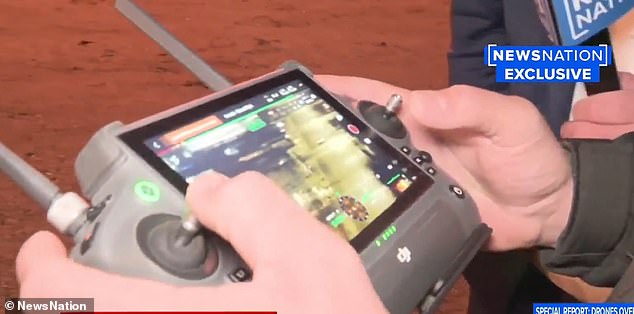- Watch The JD Rucker Show every day to be truly informed.
There is a big reason supporting the idea that the so-called “drones” are actually advanced technology. A report from law enforcement Friday night indicated they do not have a heat signature. This should be impossible for a vehicle with an 8-foot wingspan that can sustain flight and move as rapidly as they do.
This leads to two possible conclusions, assuming the equipment used and operators manning the heat-tracking drones were not faulty. The first possibility is advanced technology of some sort… definitely not a regular drone. The second is that the “drones” are illusions, like holograms projected in the sky. But that would also require technology beyond what we currently know exists because they project light outward without being tethered by the light source.
The theory that's starting to make more sense about the "drones" is that they're advanced technology, possibly from our own government, being tested in front of civilians.
"NJ Drones Have No Heat Signature Which Should Be Impossible" pic.twitter.com/LVHfXEnMSH
— JD Rucker (@JDRucker) December 14, 2024
I covered this on today’s episode of The JD Rucker Show. Here’s the source information from Daily Mail…
(Daily Mail)—A New Jersey police department has sparked concern after it revealed that a drone it sent up to track a mystery aircraft ‘easily’ evaded their device before disappearing into thin air.
Ocean County Sheriff Michael Mastronardy said his force launched its drone after one of his officers saw 50 unmanned aerial vehicles, ‘coming off the ocean’.
The officer dialed 911 to alert state police, the FBI and the Coast Guard.
The maritime agency then reported seeing spotted 13 drones following their boat, estimating that the devices had a wingspan of eight feet.
The maritime agency then reported seeing spotted 13 drones following their boat, estimating that the devices had a wingspan of eight feet.
Matronardy told NewsNation‘s Rich McHugh the force put up an ‘industrial grade’ drone to follow one of the devices, but it quickly slipped through their grasp.
The incident is just one of many drone sightings concerning locals in the Garden State and beyond.
‘If this is not our military, then it’s even more scary,’ McHugh said.
On Friday, White House National Security Communications Advisor John Kirby insisted that the public had nothing to fear, despite the mass sightings.
Kirby said most reports were likely to be cases where manned aircraft were mistaken for drones.
They launched the drone after an officer reported seeing 50 mysterious flying objects coming in off the ocean
But he admitted that officials were still struggling to corroborate some of the sightings and urged the public to continue to submit reports of any unusual activity.
Ocean County Sheriff’s Office said it has been struggling to track the flying objects as they don’t give off heat like regular drones.
‘We don’t know [why]. It’s not something we’ve had our hands on or experienced,’ one officer said.
McHugh also saw the drones and presented his findings on Elizabeth Vargas Reports, admitting the discovery left him stunned.
‘If this is not the military, it is even more terrifying. These things look like they are fixed-wing and they have multiple lights,’ he said.
‘I’m not really sure how to process what I saw last night. Both the photographer and I were kind of stunned.’
The first drone sightings appeared over the US Army’s Picatinny Arsenal and over Donald Trump’s golf course in Bedminster on November 18.
Since then the FBI has since received more than 3,000 tips, with reports of varying levels of credibility cropping up in at least 12 counties throughout New Jersey, as well as eastern Pennsylvania and Orange County, New York.
The sightings are among scores which have been causing alarm in New Jersey and beyond
As hysteria began to spread across the country, president-elect Donald Trump led calls for greater transparency.
He demanded the drones flying over multiple US states be shot down by the Biden White House after days of mysterious sightings across the sky.
He didn’t directly address the sightings over his club, but urged action from Joe Biden and the government in a Truth Social post Friday.
He wrote: ‘Mystery Drone sightings all over the Country. Can this really be happening without our government’s knowledge. I don’t think so! Let the public know, and now. Otherwise, shoot them down!!! DJT.’
His comments were echoed by New Jersey lawmakers as well as representatives from other states.
However, former FBI counter-drone specialist Robert D’Amico told DailyMail.com that shooting the drones down would be reckless and could result in serious injury or death.
He suggested that the uptick in reports is more likely due to ‘hysteria’ focusing more untrained eyes on the sky, as well as people launching their own drones to try and figure out what’s going on.
Five Things New “Preppers” Forget When Getting Ready for Bad Times Ahead
The preparedness community is growing faster than it has in decades. Even during peak times such as Y2K, the economic downturn of 2008, and Covid, the vast majority of Americans made sure they had plenty of toilet paper but didn’t really stockpile anything else.
Things have changed. There’s a growing anxiety in this presidential election year that has prompted more Americans to get prepared for crazy events in the future. Some of it is being driven by fearmongers, but there are valid concerns with the economy, food supply, pharmaceuticals, the energy grid, and mass rioting that have pushed average Americans into “prepper” mode.
There are degrees of preparedness. One does not have to be a full-blown “doomsday prepper” living off-grid in a secure Montana bunker in order to be ahead of the curve. In many ways, preparedness isn’t about being able to perfectly handle every conceivable situation. It’s about being less dependent on government for as long as possible. Those who have proper “preps” will not be waiting for FEMA to distribute emergency supplies to the desperate masses.
Below are five things people new to preparedness (and sometimes even those with experience) often forget as they get ready. All five are common sense notions that do not rely on doomsday in order to be useful. It may be nice to own a tank during the apocalypse but there’s not much you can do with it until things get really crazy. The recommendations below can have places in the lives of average Americans whether doomsday comes or not.
Note: The information provided by this publication or any related communications is for informational purposes only and should not be considered as financial advice. We do not provide personalized investment, financial, or legal advice.
Secured Wealth
Whether in the bank or held in a retirement account, most Americans feel that their life’s savings is relatively secure. At least they did until the last couple of years when de-banking, geopolitical turmoil, and the threat of Central Bank Digital Currencies reared their ugly heads.
It behooves Americans to diversify their holdings. If there’s a triggering event or series of events that cripple the financial systems or devalue the U.S. Dollar, wealth can evaporate quickly. To hedge against potential turmoil, many Americans are looking in two directions: Crypto and physical precious metals.
There are huge advantages to cryptocurrencies, but there are also inherent risks because “virtual” money can become challenging to spend. Add in the push by central banks and governments to regulate or even replace cryptocurrencies with their own versions they control and the risks amplify. There’s nothing wrong with cryptocurrencies today but things can change rapidly.
As for physical precious metals, many Americans pay cash to keep plenty on hand in their safe. Rolling over or transferring retirement accounts into self-directed IRAs is also a popular option, but there are caveats. It can often take weeks or even months to get the gold and silver shipped if the owner chooses to close their account. This is why Genesis Gold Group stands out. Their relationship with the depositories allows for rapid closure and shipping, often in less than 10 days from the time the account holder makes their move. This can come in handy if things appear to be heading south.
Lots of Potable Water
One of the biggest shocks that hit new preppers is understanding how much potable water they need in order to survive. Experts claim one gallon of water per person per day is necessary. Even the most conservative estimates put it at over half-a-gallon. That means that for a family of four, they’ll need around 120 gallons of water to survive for a month if the taps turn off and the stores empty out.
Being near a fresh water source, whether it’s a river, lake, or well, is a best practice among experienced preppers. It’s necessary to have a water filter as well, even if the taps are still working. Many refuse to drink tap water even when there is no emergency. Berkey was our previous favorite but they’re under attack from regulators so the Alexapure systems are solid replacements.
For those in the city or away from fresh water sources, storage is the best option. This can be challenging because proper water storage containers take up a lot of room and are difficult to move if the need arises. For “bug in” situations, having a larger container that stores hundreds or even thousands of gallons is better than stacking 1-5 gallon containers. Unfortunately, they won’t be easily transportable and they can cost a lot to install.
Water is critical. If chaos erupts and water infrastructure is compromised, having a large backup supply can be lifesaving.
Pharmaceuticals and Medical Supplies
There are multiple threats specific to the medical supply chain. With Chinese and Indian imports accounting for over 90% of pharmaceutical ingredients in the United States, deteriorating relations could make it impossible to get the medicines and antibiotics many of us need.
Stocking up many prescription medications can be hard. Doctors generally do not like to prescribe large batches of drugs even if they are shelf-stable for extended periods of time. It is a best practice to ask your doctor if they can prescribe a larger amount. Today, some are sympathetic to concerns about pharmacies running out or becoming inaccessible. Tell them your concerns. It’s worth a shot. The worst they can do is say no.
If your doctor is unwilling to help you stock up on medicines, then Jase Medical is a good alternative. Through telehealth, they can prescribe daily meds or antibiotics that are shipped to your door. As proponents of medical freedom, they empathize with those who want to have enough medical supplies on hand in case things go wrong.
Energy Sources
The vast majority of Americans are locked into the grid. This has proven to be a massive liability when the grid goes down. Unfortunately, there are no inexpensive remedies.
Those living off-grid had to either spend a lot of money or effort (or both) to get their alternative energy sources like solar set up. For those who do not want to go so far, it’s still a best practice to have backup power sources. Diesel generators and portable solar panels are the two most popular, and while they’re not inexpensive they are not out of reach of most Americans who are concerned about being without power for extended periods of time.
Natural gas is another necessity for many, but that’s far more challenging to replace. Having alternatives for heating and cooking that can be powered if gas and electric grids go down is important. Have a backup for items that require power such as manual can openers. If you’re stuck eating canned foods for a while and all you have is an electric opener, you’ll have problems.
Don’t Forget the Protein
When most think about “prepping,” they think about their food supply. More Americans are turning to gardening and homesteading as ways to produce their own food. Others are working with local farmers and ranchers to purchase directly from the sources. This is a good idea whether doomsday comes or not, but it’s particularly important if the food supply chain is broken.
Most grocery stores have about one to two weeks worth of food, as do most American households. Grocers rely heavily on truckers to receive their ongoing shipments. In a crisis, the current process can fail. It behooves Americans for multiple reasons to localize their food purchases as much as possible.
Long-term storage is another popular option. Canned foods, MREs, and freeze dried meals are selling out quickly even as prices rise. But one component that is conspicuously absent in shelf-stable food is high-quality protein. Most survival food companies offer low quality “protein buckets” or cans of meat, but they are often barely edible.
Prepper All-Naturals offers premium cuts of steak that have been cooked sous vide and freeze dried to give them a 25-year shelf life. They offer Ribeye, NY Strip, and Tenderloin among others.
Having buckets of beans and rice is a good start, but keeping a solid supply of high-quality protein isn’t just healthier. It can help a family maintain normalcy through crises.
Prepare Without Fear
With all the challenges we face as Americans today, it can be emotionally draining. Citizens are scared and there’s nothing irrational about their concerns. Being prepared and making lifestyle changes to secure necessities can go a long way toward overcoming the fears that plague us. We should hope and pray for the best but prepare for the worst. And if the worst does come, then knowing we did what we could to be ready for it will help us face those challenges with confidence.






